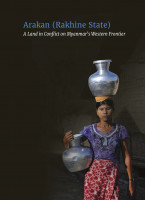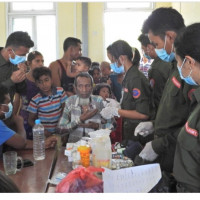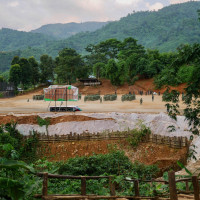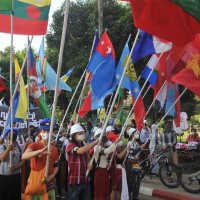The Dynamics of Arakan Politics and the Possibility of Another War A Myanmar Commentary by Kyaw Lynn
Tensions are rising in Arakan (Rakhine State) where a ceasefire exists between the Myanmar military government and Arakan Army. On the surface, the relative stability contrasts with the chaos that has enveloped many other parts of the country following last year’s coup. In this commentary, Kyaw Lynn analyses the changing landscape highlighting that, while confrontations are occurring, neither side appears yet ready to return to open warfare. “Retaliatory” actions, though, are increasing.
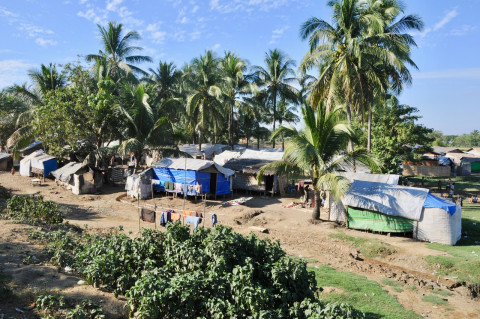
TNI
Twenty months after an informal ceasefire between the Myanmar military and Arakan Army (AA), social and political stability in Arakan (Rakhine State) are deteriorating, leading many local people to worry about the future. Many changes have taken place in the country since the introduction of this de facto ceasefire, not least the coup by the military State Administrative Council (SAC) in February 2021. And it now seems that both parties to the agreement – the Myanmar military and AA – are starting to recalculate their military strategies and political interests. Tit for tat actions have become commonplace. This was highlighted on 22 June, when SAC troops arrested 30 local Rakhine people in response to the AA arresting three government staff from the “Intelligence and Investigation Department” in Mrauk-U, the ancient capital of Arakan and one of the most conflict-sensitive townships in Rakhine State.
Before this event, tensions were visibly growing between the SAC and the United League of Arakan (ULA), the political wing of the AA. In the preceding weeks, the AA had arrested military and police force members in Kyauktaw, Ponnagyun and Tin Nyo, Mrauk-U township, as well as Ramree in southern Rakhine State. As an explanation, the ULA-AA spokesperson Khaing Thu Kha told a party press conference on 14 June that they had been arrested in response to the growing number of ULA and AA members being seized by the SAC authorities in different parts of the state. “Hostage exchange” is possible, he said, if the SAC is willing. In the ULA-AA’s defence, he argued that the arrests were an “equivalent retaliation” for the SAC’s breaking the promises of the informal ceasefire not to arrest unarmed and non-uniformed members on both sides. Khaing Thu Kha also had sobering words of warning. During the press briefing, he repeatedly stated that the outbreak of “another war” could happen at any time and that mediation through third parties was not working.
The people continue to watch the situation closely. But the past month has not shown any notable improvements, and it seems that the spate of arrests are just the tip of the iceberg in revealing deeper reasons for the changing trends in Arakan politics. A critical time is approaching.
A ceasefire of distrust
When the informal ceasefire was initiated in November 2020, it caused surprise for many people both inside and outside of the country. Coming in the aftermath of the 2020 general election, the timing seemed odd, and for many observers the real intentions of the leaders of the Myanmar military for accepting such a ceasefire were only revealed when they staged their coup on 1 February 2021. Until the ceasefire turning-point, it was Myanmar’s military leaders who had always refused to recognise the ULA-AA’s existence in Arakan and insisted that they would eradicate the movement by military means in line with their “black and white” definitions of combatting opponents. In essence, “white” areas are those that the government is perceived to control and “black” are under armed opposition which, military leaders say, must be destroyed.
Certainly, in the months following the coup the SAC leaders sought to take advantage in Arakan by a combination of different measures. On the political front, the SAC attempted to build on the rivalry between the National League for Democracy (NLD) and Rakhine political parties – the Arakan National Party (ANP) and Arakan Front Party (AFP) – in the electoral space. To try and achieve legitimacy for the SAC, a number of ANP members were included in SAC administrative structures and Dr. Aye Maung, the AFP chair and a former ANP leader, was released from prison. Such gestures appeared more profitable for the SAC in Rakhine State where, given the electoral opposition to the NLD in many constituencies (especially in the north and centre of the state), the regime faced less protest reaction in urban areas when compared to other parts of the country following the coup.
During these difficult months, the AA ceasefire further added to a lessening in security and political challenges faced by the regime after the SAC’s assumption of power – both in Arakan and Myanmar at large. For several months the security situation appeared more stable in Arakan in contrast to the chaos that had enveloped other parts of the country following the coup. This meant that, at the union level, the SAC military no longer needed to provide intensive operational attention to Rakhine State which, until the AA ceasefire, had been the most active conflict region in Myanmar. In line with this new strategy, the SAC leadership sought to contain ULA-AA activities on the one hand while taking profits from political stability and economic extraction on the other. Located on the country’s western seaboard, Rakhine State is an important source of revenue to the regime, including oil and gas pipelines that run to Yunnan Province in China.
Containing the ULA-AA, however, did not prove a simple option after several years of warfare. To implement this policy, a raft of activities was laid out. These included re-building military and police apparatus across the state and adjoining Paletwa township in Chin State where the ULA-AA is also based; increasing intelligence surveillance; re-organising broken administrative structures by forcing village-tract leaders not to cooperate with the ULA authorities; and threatening ULA administrative and judiciary activities in territories that the SAC regards as its exclusive sphere of influence.
The main focus of these pressures was generally in urban areas of northern Rakhine State as well as southern townships, such as Kyaukpyu, Ramree and Taungup, where there had been no strong AA movement during the previous round of conflict. At the same time, the SAC military presence was reinforced by the maintenance of trade and travel sanctions inside and along the borders of Rakhine State. In essence, although the truce was sustained, many people experienced a more difficult economic and security situation following the 2020 ceasefire.
Inevitably, such behaviour proved unacceptable to the ULA-AA leadership. After several months of ceasefire initiation, the ULA-AA chief, Gen. Twan Mrat Naing, declared the movement’s policy of “state-building” and “nation-building” as the fundamental task of the Arakan people on 10 April 2021 on the 12th anniversary of the Arakan Army’s foundation. ULA-AA leaders also called for faster action to support progress on the ground in the ceasefire aftermath. After three years of intense conflict and deepening poverty, the ULA-AA wanted to prioritise reconstruction, resettle displaced peoples, build new infrastructure and promote socio-economic development for the general population while securing political stability in Rakhine State.
For this reason, Yohei Sasakawa, Japan’s Goodwill Ambassador for the Welfare of the National Races in Myanmar and Chairman of the Nippon Foundation, had been welcomed to play a visible role in the initiation of the Arakan ceasefire. However, within months of the SAC coup, it quickly became clear that the situation was not developing as the ULA leadership had desired. While trying to crack down on the expansion of ULA administrative and judiciary systems in southern Rakhine State, the SAC was continuing to impose trade and travel restrictions on local communities across the territory.
The ULA-AA spokesperson Khaing Thu Kha spoke openly of deepening concerns at the party press conference in June this year:
“We, the ULA-AA, are waiting and watching such aggressive and inhospitable actions of the SAC authority as we want more freedom and better socio-economic conditions for our people while maintaining political stability in Rakhine State. However, if their actions are becoming more aggressive than we can tolerate, we want to warn that it could lead to an even greater deterioration in relations.”
As tensions continue to deepen, many people are asking the same question: “What do we actually get from a de facto ceasefire like this?”
Ceasefire in Arakan but fighting in other areas
In his 2021 address on the 12th anniversary of the AA’s foundation, Gen. Twan Mrat Naing stated that the ULA-AA does not want the Civilian Disobedience Movement and other anti-military or pro-democracy movements to become active in Arakan because the organisation has its own “Way of Rakhita” philosophy to bring about social and political change. Since this time, many people in Arakan and outside became interested in what the “Way of Rakhita” means and how it can guide the civil and political movements in Rakhine State in the face of the complex political landscape that exists countrywide.
There is, in fact, no official definition or document about the “Way of Rakhita”. But based on interviews and speeches by the ULA-AA leadership, it is usually summarised as a “way of thinking which is solely based on the national interest of Arakan people rather than any other philosophical or political values and principles.” In line with this philosophy, the ULA-AA leadership started to re-shape the politics of Arakan in new ways following the SAC coup. At the time, they thought this strategy would be better following the ceasefire in pursuit of their political goals and interests.
In Gen. Twan Mrat Naing’s most recent speech, however, there was a very different tone. Speaking two months ago on the 13th anniversary of the AA founding, he said: “Comrades, be ready to fight when ordered!”
It was an occasion that attracted attention. On the same day, the rival National Unity Government (NUG) and more than a dozen armed opposition groups, including the (Kokang) Myanmar National Democratic Alliance Army and Ta’ang National Liberation Army, sent their own “congratulatory statements” in solidarity with the ULA-AA. Notably, a number of these movements are newly established since the coup and are engaged in anti-SAC military activities in other parts of the country. New groups include the Burma People`s Liberation Army, Student Armed Force, People’s Revolutionary Alliance (Magway), Karenni National Defence Force, Asho Chin Defence Force, Mara Defense Force and Chin Defence Force (Mindat). In some of their statements, they mentioned the support of the ULA-AA in terms of military training and equipment.
This is not the only link that exists between the ULA-AA and anti-SAC movements. News has continued to emerge about AA soldiers fighting – or being present – in conflict frontline areas in Kachin and northern Shan States alongside other ethnic armed organisations since the SAC coup. In a recent example, six AA soldiers were killed in an air raid in Karen State in early July where they were stationed in territory administered by the Karen National Union (KNU). Technically, the KNU also has a ceasefire with the Myanmar military (initiated in 2012), and the air strike was considered a hostile act. But it is generally safe to argue that the AA, outside of Arakan, has not truly been under a ceasefire following the SAC takeover.
Against this backdrop, relations between the SAC and ULA-AA leaderships have been stalling. A lower-level ULA political team attended the 73rd anniversary of Union Day, held by the SAC at Nay Pyi Taw in February, where they argued for the release of their members who have been arrested. But ULA-AA leaders declined a peace talk invitation by the SAC Chairman, Sen-Gen. Min Aung Hlaing, in May this year. Although two key ULA-AA allies in the Federal Political Negotiation and Consultative Committee – the United Wa State Army and National Democratic Alliance Army – chose to participate in the talks, the ULA-AA did not release an official statement explaining their refusal. But one informal response by the ULA Secretary Dr. Nyo Twan Awng appeared on social media: “The SAC still does not change its policy about ethnic rights for the peace talks.” Reflecting the deepening divide, the NUG then declared its recognition of the “Arakan People’s Government”, which is led by the ULA, at the end of May following an online meeting between NUG and ULA leaders.
All such events are raising speculation in Arakan politics. During the past two years, changes have happened rapidly, and the path that the ULA-AA is following is sure to make the SAC leadership angry. However it is still too early to say that the ULA is totally on the side of the NUG against the SAC, and it will mostly like not want to choose one “government” over another in the struggle between the two camps: the SAC and NUG. In explanation of this ambiguity, the strategy of ULA leaders cannot be understood on the basis of dialectical thinking between the SAC or NUG but only realised through the “Way of Rakhita” philosophy, which is centred upon the “Arakan National Interest” and not subject to any outside political domain.
The Rohingya crisis: old challenges and new questions
Adding to the complexity of pressures, the question of the Rohingya community in Arakan is also becoming more difficult to answer. On 21 June, the ULA released a statement warning the people to avoid a recurrence of communal violence in Rakhine State due to a series of incidents that were causing tensions to rise and accused the SAC of being involved. These included the kidnapping of two ethnic Rakhine teachers in Maungdaw township, who were released one week later in exchange for 5 million takas on the Bangladesh side of the border, and the bullying and beating of a young Rohingya man in Pauktaw township. Subsequently, the ULA-AA leader Gen. Twan Mrat Naing accused the Arakan Rohingya Salvation Army of being the culprit behind the kidnappings, stating that this was a grave disservice to efforts for social cohesion and trust-building among communities in Arakan as well as to Rohingya refugees who want to come back to their homes.
The situation, however, is much changed since the first round of communal violence in 2012. Large segments among both communities today believe that they cannot allow another outbreak of violence in Rakhine State and, if this happened, it would only prove beneficial to the SAC which prefers the tactics of “divide and rule” to cause disharmony among different peoples and communities. At the same time, it needs to be recognised that community reconciliation in Rakhine State is not an all-finished task, and there is still no common vision about the future of Arakan.
This theme was taken up in a recent International Crisis Group (ICG) report about the political situation in Arakan, which made a number of points suggesting the formalization of the informal ceasefire with the initiation of a Rohingya repatriation process.* The ICG recommendations, which are based on achieving tripartite relations between SAC, ULA and Bangladesh government, are quite welcoming on a peace and repatriation process. There are, however, still many challenges in implementing such a sensitive programme due to the rise in political instability and lack of common understanding between the different actors and communities that need to become involved.
Despite the desire to avoid any repetition of communal violence, many different opinions still exist on the ground. For example, there has been a significant change in perceptions among the ethnic Bamar majority since the SAC coup as well as a NUG policy declaration towards addressing the Rohingya crisis. But these views cannot be regarded as the same as those of ULA-AA leaders nor the Rakhine majority population in Arakan. Similarly, while there is competition between SAC and NUG leaders over gaining international recognition for their governments in handling the Rohingya issue, the ULA-AA is much more focused on building local and international support for the achievement of an Arakan State as part of any process of resolving the Rohingya and other socio-political challenges. The SAC, NUG and ULA see the Rohingya crisis with very different priorities and perspectives.
In summary, collaboration will be needed among different actors to solve the Rohingya crisis, and this will mean mediation among competing interests. But, at present, this will not be an easy task at all.
The possibility of another war in Arakan
For the moment, it is difficult to estimate the possibility of a resumption of armed conflict in Arakan, and how this might come about. Politics aside, there are other strategic interests that both parties to the ceasefire have to consider. Two, in particular, stand out: intention and capability. Both play important roles in the power competition between the two sides, with the expansion of either party – and hence its capacity – making the other doubtful about their rival’s intentions and vice-versa. As such, an increase in capability has the potential to change the intention of one side or the other at any time. Such is the state of play in Arakan.
For this reason, one of the key factors hindering another outbreak of armed conflict in Arakan is the lack of a clear “war mission” for both parties. The current situation, both in Arakan and the country more generally, encourages both parties to keep to the ceasefire status quo and be generally defensive about developing and implementing another war strategy due to their limited capacities on the ground. It is also very difficult to relate the post-coup combat involving new People’s Defence Forces and other anti-SAC movements in other parts of the country, where there are no ceasefires, to the particular challenges in Arakan. In essence, both SAC and ULA-AA leaders may feel that they have more to lose than gain by returning to open conflict in Arakan at this time.
If fighting breaks out, for example, the ULA-AA would be expected to try and “conquer and control” some of the urban areas and key communication channels in northern Rakhine State at the least, while the SAC would return to the familiar tactics of the Myanmar military in launching “regional clearance” operations against AA strongholds in rural and mountain areas. In the present impasse, however, both parties appear to have limited capability to carry these objectives out. For the ULA-AA gaining control of new areas requires new technology, human resource training and supplies of military equipment. In contrast, attempts at SAC “domination” will also face logistical challenges and strong resistance because the regime cannot provide enough soldiers or open new battlefronts due to the scale of fighting in other parts of the country.
Such realities indicate that the return to war in Arakan may ultimately be determined by the changing military pendulum between the SAC and anti-SAC forces in central Myanmar and the different ethnic states around other international borders. The country is presently in a deep state of civil war in which Arakan has, in many respects, been an exception until now. But this does not mean that there will be no armed clashes between SAC and ULA-AA forces in the meantime. Conditions of what can be termed “limited war” still exist in areas like Paletwa township and other disputed areas where both sides have strategic objectives. Many lives could still be lost and properties destroyed, similar to the intense fighting between 2018-20, and this time the battlefields will be even closer to the major towns and villages, especially in northern Rakhine State.
Until the present day, the AA is arresting military and police members in several front-line areas, while the SAC is apprehending civilians suspected of supporting the ULA-AA in such nationalist strongholds as Ponnagyun, Kyauktaw and Mrauk-U townships. Currently, more than 30 local people have been charged by the SAC authority under Article 505 of the Penal Code, accused of incitement or state defamation, although some have been released. Occasional clashes are still being reported, most recently in Maungdaw township where it was reported this week that 14 police and troops were captured and a number killed in a “retaliatory” AA attack for the air raid that killed six members in Karen State. And causing growing anger in local communities, the Rakhine Ethnic Congress reported in early July that six civilians had been killed and eleven wounded during the previous two months in explosions caused by landmines which the SAC military is planting outside its bases. All such incidents are putting pressure on the ULA leadership to fight back against the SAC.
Many fear that, whether it suits the SAC or ULA-AA or not, the clock towards a return to open warfare is now ticking. In the international community, there is only one country which can seek to manage the unpredictable and changing dynamics in Arakan: that is China. With strategic and economic interests, Chinese officials have relationships with all sides on Myanmar’s political divides.
The situation is different for Western governments. But there are still many things that they can try in order to prevent the outbreak of war in Arakan. They know that Western engagement with the SAC risks legitimatization of the regime which is an outcome that all wish to avoid. Instead, they can prepare in providing emergency and humanitarian assistance through different channels, including trans-border through the Bangladesh and India borders. There is also potential, as the ICG has suggested, that reaching a formal ceasefire agreement between the Myanmar military and the Arakan Army might – at some stage in the future – prevent a further humanitarian disaster and provide the chance for Rohingya refugees in Bangladesh to return to Arakan.
This is not, however, the time for naivety nor failure to understand the complexity of challenges in Arakan and Myanmar at large. The aspirations, needs and perceptions of the people must come first. And, in this respect, the current trends in national politics are loading more weight into negative directions where the future of Arakan is concerned.
Kyaw Lynn is a post-graduate student mastering in Political Science at the University of Yangon. He is also a freelance political analyst in Yangon as well as one of the founders of the Institute for Peace and Governance.
* International Crisis Group, “Avoiding a Return to War in Myanmar’s Rakhine State”, Report 325, Asia, 1 June 2022.
